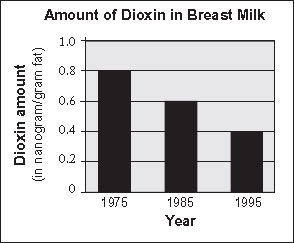This task received a difficulty value of 280, the lower end of Level 3. The
graph clearly indicates that the amount of Dioxin decreased over each of the
three time periods, yet some adults have difficulty coping with such a task, which
is based on a stimulus with a structure that commonly appears in newspapers,
i.e., brief text plus a graph. The increased difficulty level of this item may be
attributable in part to the need for adults to generate their own description, to
the moderate amount of dependence on text needed to comprehend the context
to which the graph refers, or to the need to understand the direction of the decimal
values on the vertical axis (which is common in reporting on concentrations of
contaminating chemicals).
Is breast milk safe?

Since the 1970s, scientists
have been worried about the
amount of Dioxin, a toxin in fish
caught in the Baltic sea. Dioxin
tends to accumulate in breast milk
and can harm newborn babies.
The diagram shows the
amount of Dioxin in the breast milk
of North European women, as
found in studies done from 1975 to 1995.
A second and more difficult task using this same stimulus directed adults
to compare the per cent of change in Dioxin level from 1975 to 1985 to the per
cent of change in Dioxin level from 1985 to 1995, determine which per cent of
change is larger, and explain their answer. This task was considerably more difficult
for adults in participating countries and received a difficulty value of 377 on the
numeracy scale. Here the necessary information is embedded within the graph
and requires a level of transformation and interpretation. To arrive at a correct
response, adults have to look at the rate of change expressed in per cents, not just
the absolute size of the change. Further, they have to work with per cents of
entities smaller than one (i.e., the decimal values on the vertical axis) and realize
that the base for the computation of per cent change shifts for each pair. It seems
that the need to cope with such task features, use formal mathematical procedures,
or deal with the abstract notion of rate of change, adds considerable difficulty to
such tasks.
